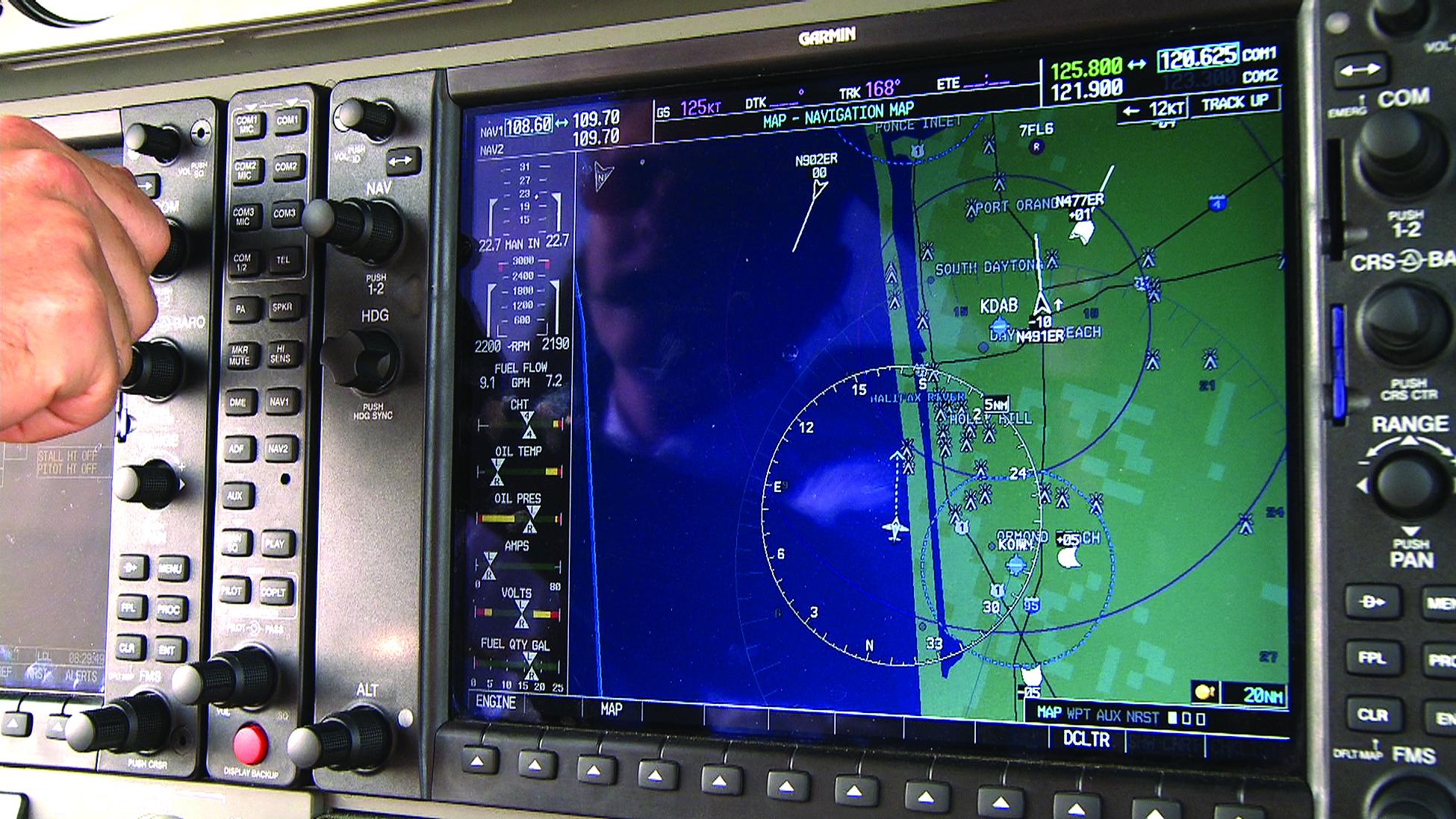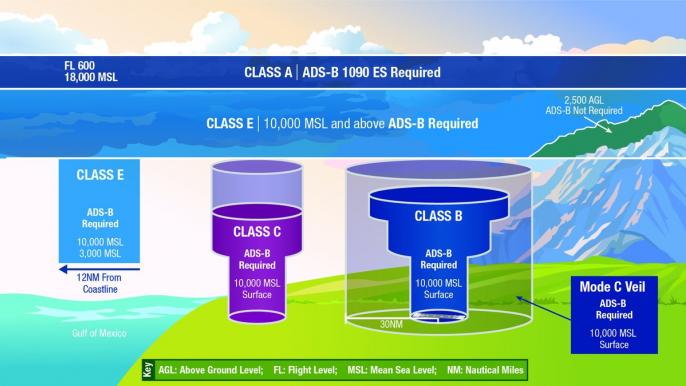
Commercial carriers lead business aviation in pursuing operational benefits from receiving and displaying traffic information on their flight decks by automatic dependent surveillance-broadcast (ADS-B) In.
Initial interest in ADS-B In applications by the general aviation (GA) community is coming from pilots who want to improve their situational awareness by streaming uplinked weather and traffic information to their carry-on devices through applications like ForeFlight and Garmin Pilot.
“We are seeing some demand where folks want to install an ADS-B In receiver and a wireless adaptor, and then they can see those data on their iPads, for example,” says Bill Stone, Garmin Aviation senior business development manager. “I think we see a lot more demand for ADS-B In in the smaller, owner-flown aircraft where they may not have airborne weather radar and they likely don’t have a TCAS [traffic alert and collision avoidance system], so it really is good value for them.”
In 2010, the FAA mandated that all aircraft flying in most controlled airspace in the U.S. transmit their position by ADS-B Out by January 2020. Since the compliance deadline, nearly all commercial airliners--more than 6,700 by the FAA’s count in February 2021--had equipped for the requirement, and an estimated 90% or more of all business jets also had done so.
ADS-B Out provides greater overall surveillance coverage, better accuracy and higher update rates than radar. The FAA is taking advantage of the technology to gradually close aircraft separations to 3 nm from 5 nm in en route airspace, which also benefits operators by improving air traffic flows in congested airspace.
But ADS-B In--the capability to see aircraft targets on the flightdeck and exploit that data operationally--has been acknowledged from the start as industry’s payback for investing in ADS-B Out. While the FAA mandates that operators broadcast an aircraft’s position by ADS-B Out, it does not require that they also be capable of ADS-B In.
The infrastructure the FAA built already supports some ADS-B In applications. Traffic information service-broadcasts (TIS-B) transmit relevant traffic position reports derived from ADS-B, radar and multi-lateration sensors to aircraft fitted with ADS-B 1090ES or 978 MHz UAT receivers flying at or below 24,000 ft. within coverage of a ground station. Flight information service-broadcasts (FIS-B) transmit aeronautical and weather information to aircraft that can receive data over UAT while flying within ADS-B coverage.
Through flight trials, airlines have advanced more sophisticated ADS-B In applications, such as Cockpit Display of Traffic Information-Assisted Visual Separations (CAVS) and In-Trail Procedures (ITP), that require display and software enhancements and new procedures.
Under the Single European Sky ATM Research program, Honeywell has advanced its SURF-IA (Situational Awareness on the Airport Surface with Indications and Alerts) application with support from Airbus, Dassault Aviation and Eurocontrol. The software-based system provides pilots with visual and audio warnings of approaching hazards on the airport surface, based on ADS-B Out data.
After nearly a decade of development--originally as US Airways--American Airlines started installing SafeRoute+, an ADS-B In retrofit system, on its fleet of 319 Airbus A321s in 2020. A product of ACSS, a joint venture of L3Harris Technologies and Thales, SafeRoute+ is an upgrade to the aircraft’s ACSS TCAS surveillance processor that uses existing cockpit multifunction control and primary flight displays with the addition of a small ADS-B Guidance Display. The launch version supported five ADS-B In software applications.
The FAA’s NextGen Advisory Committee (NAC) has designated ADS-B Out as one of four “fundamental” items (with performance-based navigation, data communications and inertial reference units) of a Minimum Capabilities List of forward-fit equipment it has developed for mainline and regional airliners. It has identified ADS-B In as one of 12 optional, supplemental items.
In August 2020, the FAA asked the advisory committee to develop a comprehensive list of ADS-B In commercial applications its airline members either have or intend to invest in within the next five to 10 years, as well as a list of promising future applications. “Through discussions with the NAC, the FAA has become aware that several large air carriers and cargo carriers have begun to invest in ADS-B In applications,” states an agency tasking letter. It called on the NAC, which meets next on March 18, to produce a report in spring 2021.
As of February 2021, the FAA reported that 150,868 total U.S. aircraft were equipped for ADS-B Out position reporting, of which 136,655 were “good installs” and 14,213 deemed “non-performing emitters” (NPE) that were transmitting incorrectly due to misinstalled software or avionics. There were 104,078 general aviation fixed-wing aircraft equipped, with 94,869 good installs and 9,209 NPEs.
The FAA sends a letter to inform operators when its ADS-B Performance Monitor detects a non-complying NPE aircraft. “It [occurs] across the system; there are airliners that are non-performing emitters, and that can be caused by software issues in the avionics,” says Stone. “A very high percentage of the non-performing emitters are the amateur home-built, experimental aircraft…. They’re not configured correctly. If they read the manual and test [the system] post-installation, these things would be caught.”

Aircraft owners, operators and avionics shops can request Public ADS-B Performance Reports (PAPR) from the FAA to validate the performance of ADS-B Out equipment installed on aircraft by entering the flight date and other information at adsbperformance.faa.gov/PAPRRequest.aspx
In order to address privacy concerns over third parties tracking aircraft with their own ADS-B receivers, the FAA in December 2019 launched the Privacy ICAO Address (PIA) program. The PIA program allows operators of U.S.-registered aircraft equipped with 1090ES ADS-B transponders to request an alternate, temporary ICAO aircraft address that is not attributable to the owner/operator in the Civil Aviation Registry. The FAA said it has approved 112 requests since the start of the program.
To begin the process, an operator must obtain a PAPR with the aircraft’s permanently assigned 24-bit ICAO address from a flight in ADS-B airspace within the past 180 days, then enter the required information via the PIA request site at: adsbperformance.faa.gov/PIA/Application.aspx
The rate of ADS-B Out installations by GA pilots and operators spiked from 2017-19, but has dropped off to hundreds instead of thousands of aircraft per month since the FAA regulation entered force, says Stone. Some pilots of owner-flown aircraft have elected not to equip at all, because they fly in remote parts of the country such as the Dakotas, where there is no ADS-B airspace below Class A airspace at 18,000 ft. MSL. Any flights above that require using an ADS-B 1090ES transponder. “Folks flying off the ranch don’t see value in it, so they’ve not yet equipped,” says Stone.
With the exception of “hangar queens,” or aircraft that have been stored or inactive, the operators of FAR Part 25-certified business jets had largely equipped for ADS-B Out by 2020. There is also some ongoing demand to install ADS-B Out capability on aircraft from South America that are being sold into the U.S., says Michael Kussatz, East Coast regional avionics sales manager for MRO Duncan Aviation.
“On the Part 25 side, the expense to upgrade was a lot higher, so they were usually rolling this in with a big maintenance event at the same time,” says Kussatz. “Just because of the nature of the way they operate those aircraft--they’re on a budget, they’re looking at what they need to do X years out. There was a lot of debate on whether the FAA was going to [postpone] the mandate; everybody was trying to project what they were going to do. The business jet operators couldn’t take the risk.”
Garmin supplies dual-band 978/1090ES ADS-B In receivers, and all of its display products and integrated flight decks are capable of presenting ADS-B In data when used with a receiver, said Stone. A wireless gateway is required to transmit the data to a portable device.
High-end ADS-B In software applications like those pursued by airlines, for now, are not in demand by business aviation.
“Many business jets have weather radar, they have TCAS, so they have pretty decent weather and they have good active surveillance,” says Stone. “Many of the aircraft in the legacy fleet have a legacy EFIS [electronic flight information system], where there is just no opportunity to display those data on the cockpit displays.”
Listen to the full webinar recording 'ADS-B Out And In' here to learn more.





